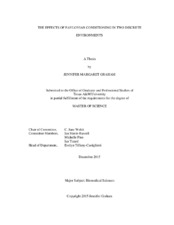| dc.contributor.advisor | Welsh, Cristabel J | |
| dc.creator | Graham, Jennifer Margaret | |
| dc.date.accessioned | 2016-04-06T16:54:07Z | |
| dc.date.available | 2017-12-01T06:36:13Z | |
| dc.date.created | 2015-12 | |
| dc.date.issued | 2016-01-08 | |
| dc.date.submitted | December 2015 | |
| dc.identifier.uri | https://hdl.handle.net/1969.1/156307 | |
| dc.description.abstract | The purpose of this literature review is to examine whether Pavlovian eye blink conditioning in the rabbit consists solely of a specific motor reflex or involves other extracerebellar control systems. Castiglioni et al. (2009) utilized a transfer design in which retention of learning in different environments and the expression of the original learning was not limited to a single motor reflex measure. Subjects were trained in a traditional Pavlovian stock to differentiate between an S+ signal of a brief tone paired with an unconditioned stimulus (US) of cutaneous shock. Then, subjects were tested for what they had learned in a different environment.
The results showed that the presentation of the S+ produced completely different behavior in the open environment as compared to the Pavlovian stock. In the restricted environment of the Pavlovian stock, presentation of the S+ produced eye blink responses without any additional motor or emotional reactions. In the transfer environment, reaction to the S+ produced: (a) a prolonged disruption of ongoing behavior, (b) a wide range of complex emotional responses, and (c) a complete absence of eye blink response. Reaction to the S- in the Pavlovian stock or in the open environment, did not elicit an eye blink response. These findings provide strong evidence that Pavlovian conditioning is not just a specific motor reflex, but instead involves a difference in meaning and significance of the S+ for the subjects when presented in two discrete environments. This is observed in the subjects’ different response patterns which unmasked a significant emotional component of the conditioning. This lead to the conclusion that nictitating membrane (NM) conditioning consists of more than an invariant, discrete cerebellar oculomotor reflex. The clear emotional component to the conditioning indicates the involvement of extracerebellar control mechanisms, potentially a widespread cerebral network in addition to the microcerebellar control of the specific motor reflex, a contradiction to current neuromodels. | en |
| dc.format.mimetype | application/pdf | |
| dc.language.iso | en | |
| dc.subject | Pavlovian conditioning | en |
| dc.subject | eye blink | en |
| dc.subject | nictitating membrane | en |
| dc.subject | rabbit | en |
| dc.title | The Effects of Pavlovian Conditioning in Two Discrete Environments | en |
| dc.type | Thesis | en |
| thesis.degree.department | Veterinary Integrative Biosciences | en |
| thesis.degree.discipline | Biomedical Sciences | en |
| thesis.degree.grantor | Texas A & M University | en |
| thesis.degree.name | Master of Science | en |
| thesis.degree.level | Masters | en |
| dc.contributor.committeeMember | Steele-Russell, Ian | |
| dc.contributor.committeeMember | Pine, Michelle | |
| dc.contributor.committeeMember | Tizard, Ian | |
| dc.type.material | text | en |
| dc.date.updated | 2016-04-06T16:54:07Z | |
| local.embargo.terms | 2017-12-01 | |
| local.etdauthor.orcid | 0000-0002-7744-8765 | |


